Derby
Sept 06
In loving Memory of Annie Mcdonald
There was a web site for Annie; it had a link for making a condolence donation to the San Martin Animal Shelter where Annie last worked. Tragically Annie was murdered by her boyfriend, who later martyred his life to the Stanislaus Sheriff's Dept. Here is Annie jumping derby in short pants and fishnet stockings. She had her own style! Miss that girl.
|
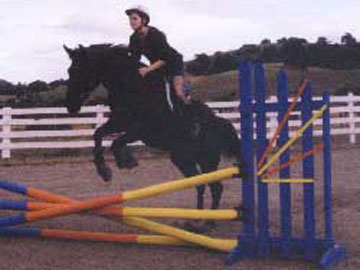 |
Years ago, Annie's mom brought her to me to learn to ride. I saw, loved, nurtured and appreciated Annie's spirit. She was independent, creative, sensitive, artistic, strong, out spoken with people close to her. When I saw Annie working at the shelter, talking on the phone, handling details, giving out information, working on the computer and greeting the public all at the same time --I saw a grown up, mature woman where once was a young teenage girl swimming through the overgrown swamp of adolescence. It is a picture I will always have in my mind anchored below the lofty feeling of pride and amazement we feel experiencing the growth of a life.
 |
The year I ran the Calero Ranch Summer Camp (1996), the ranch needed horses. The Ranch opted to lease horses from a guy who provided horses to dude ranches in the Western States. Derby came in a load of 13 horses. He was really skinny, as were all of the horses. I remember the first time i worked with him. He cow kicked when you tried to mount, tried to bite when you tightened the girth. He had saddle sores on his withers and where a cinch would ride. When I put him on the longe line he ran and bucked. Once he realized acting up wasn't going to get rid of me, he settled down and it was then easy to see he had quite a bit of training. It took very few rides to tune him up, I think he was once someone's show horse. I had to wonder how a nice horse like him ended up being trailered around from dude ranch to dude ranch. The bad habits went away really quickly. He is still a tiny bit girthy, but never bites.
Derby was soon leased by Annie's family for her and eventually Calero sold him to them in '98. |
Over the years, we did many things with Derby. When Annie was killed in '06, Derby was living on the family ranch in Hollister. He was very thin because his teeth were starting to fail . When I saw how thin he was I figured he was going to die soon. I thought it would be more trauma for the family to have Annie's horse die so soon after she had been killed, so I asked to bring him home.
In '96 the estimate by Derby's teeth was that he was about 19, that would make him in his mid to late thirties. If you can help me with Derby's care, I thank you in advance. |
Here is a video of Derby playing with Jack the mini horse  http://youtu.be/KrygDf0dRzM and a better one
http://youtu.be/KrygDf0dRzM and a better one
http://youtu.be/qRgOkxbgZ_U
Printed in the Country News.
My last article, “The Real Cost of Horses”, ended with a teaser, “ Learn about my own ignorance…Bio and Pics to come...”
The best way to learn about my bio is to visit my website, www.equestriantraining.com. However, let me give you enough background to tell you about my own ignorance with horses. Because ignorance, I said, is one of the social costs that leave 200,000 horses per year needing rescue or euthanasia. And I have rescued horses out of my own ignorance about horses and sometimes out of ignorance about rescueing.
Like many people in our South Valley, I spent a number of years working in the technical marketplace. During that time, I developed soft-tissue stress injuries, which necessitated a career and life-style change. I had put horses on the backburner since my late 20’s because of their cost, but I clearly remember the day when it occured to me that I had earned the financial means to have a dream that I once thought had passed me by.
Okay, now starts the ignorance part.... I thought I could mix my love of and knowledge about horses into an income-making lesson and training business. After all, services is where money can be made with horses. “Everybody” knows you don’t make any money boarding or breeding.
To formalize my avocation into a vocation, I became certified by American Riding Instructors Association (ARIA) www.riding-instructor.com and Certified Horsemanship Association (CHA) www.cha-ahse.
Since 1994 I have steadily worked at making my equestrian hobby become my equestrain business. I have continued my education, hands-on training, clinics, video, DVD and book learning. But knowing about and being effective with horses does not necessairily make good business. Good business in the horse industry is a whole other article, even in our South County. I look forward to exploring that in another follow-up article.
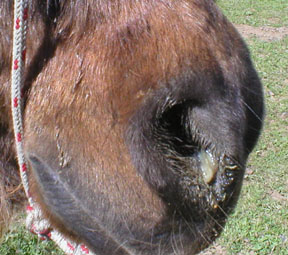 Now, back to my original article “The Real Cost of Horses” in which I said the social costs of ignorance and consumerism drive the need for horse rescue. This week, I have been desperately trying to remove the lice from an old pony that has long, curly hair from Cushings disease. Cushing’s disease makes an older animal more suseptible to parasites. Free range chickens at his old home were the probable vector for his infestation. He also has a sinus infection accompanied by putrid smelling breath and green gelatinus mucus oozing down his nose. We aren’t sure how old he is but his age has caused spaces between his teeth and receeding gums; partially chewed food migrates from between the teeth up into his sinus cavity causing the infection. Here is a picture; you can see for yourself. Thank you, Dr. Toews, for helping me making this pony comfortable and useful so he can hopefully contribute toward his own future upkeep by teaching a family about animals.
Now, back to my original article “The Real Cost of Horses” in which I said the social costs of ignorance and consumerism drive the need for horse rescue. This week, I have been desperately trying to remove the lice from an old pony that has long, curly hair from Cushings disease. Cushing’s disease makes an older animal more suseptible to parasites. Free range chickens at his old home were the probable vector for his infestation. He also has a sinus infection accompanied by putrid smelling breath and green gelatinus mucus oozing down his nose. We aren’t sure how old he is but his age has caused spaces between his teeth and receeding gums; partially chewed food migrates from between the teeth up into his sinus cavity causing the infection. Here is a picture; you can see for yourself. Thank you, Dr. Toews, for helping me making this pony comfortable and useful so he can hopefully contribute toward his own future upkeep by teaching a family about animals.
 Luckily, lice on horses can’t be transferred to people and Dr. Toews thought it not too likely that lice would spread to horses not in contact with the pony. Only three other horses also had to have lice treatment. This is better than all 15 horses at equestriantraining.com. The pony had to be shaved, put on antibiotics and given a soft diet that required less chewing. The pony and the three horses that live with him need a lice bath once a week for three weeks.
Luckily, lice on horses can’t be transferred to people and Dr. Toews thought it not too likely that lice would spread to horses not in contact with the pony. Only three other horses also had to have lice treatment. This is better than all 15 horses at equestriantraining.com. The pony had to be shaved, put on antibiotics and given a soft diet that required less chewing. The pony and the three horses that live with him need a lice bath once a week for three weeks.
How does this happen to horses? How do they slip through the cracks in our care. In this case I will tell you, because it is “relative”. Their care is relative, that is, directly related to conditions in our own human lives, their care is relative to our own human needs to be comforted or to provide comfort. Their care is relative.
This pony came from a family with an incredible history in animal rescue. This family’s 24-year-old daughter worked for the San Martin Animal Shelter and brought home chickens, ducks, goats, sheep, cats, dogs, even hairless hamsters in the years she worked at the shelter. She did this out of love for animal and to rescue them. After this daughter moved away from home, she would chastise her mother for not daily checking the dog’s toes for foxtails that were picked up while the dogs romped on their 20 acre property. I think the family’s daughter also rescued snakes, birds and even people.
This young, animal-loving woman came by it naturally, rescueing animals. Her mother once rushed to the house for a butcher knife in a desperate attempt to save an unborn foal when the woman’s favorite mare suddenly dropped dead of a heart attack in her tenth month of pregnancy. Her husband came home to find her sobbing, covered in blood with a dead, evicerated carcass and a wet, limp and motionless paint foal.
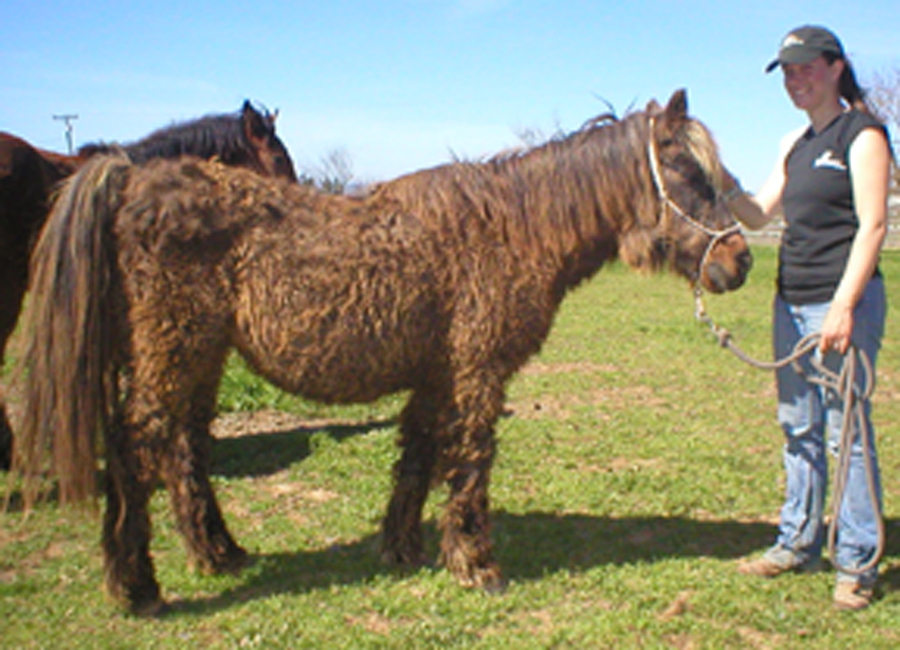
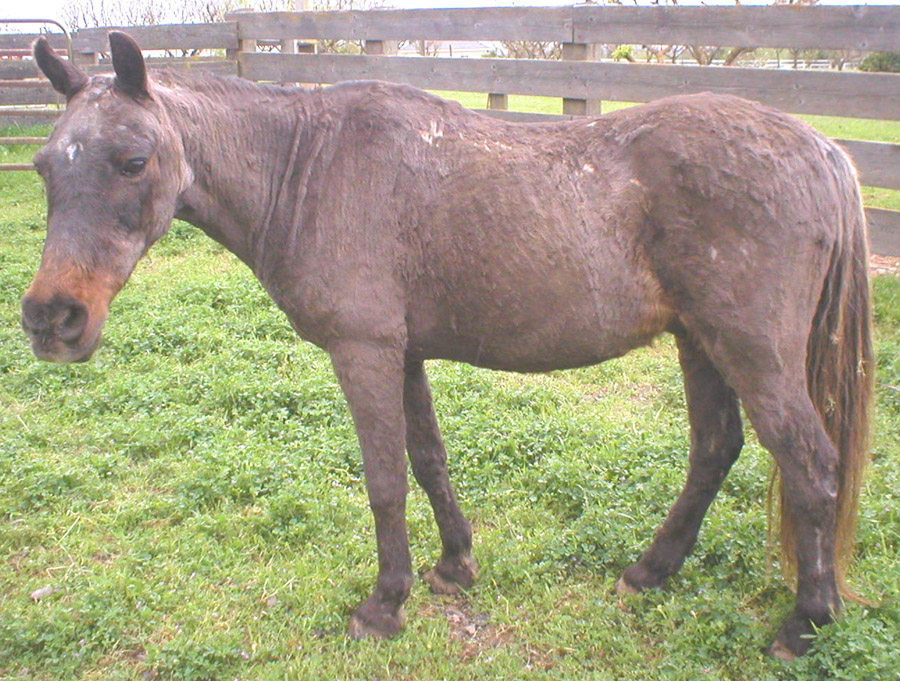
The pony was purchased for their youngest daughter several years before. He had been well cared for as he advanced in age, with numerous dollars spent in care for the side effects of his Cushings disease.
This past weekend, as the family’s mother and I shaved the pony, we discussed the lice and other related problems that came my way from having the family’s five horses. She said she had barely fed them the past six months. Not meaning that they weren’t fed, but that she was so detatched from them that her husband had been feeding them.
Six months ago her daughter was murdered. Every day, I look at her daughter’s picture on my dresser and on my computer desk. Every day, I still cannot concieve that she is gone, every day I feel a strange hole in understanding how someone so beautiful in soul and body was killed by an animal that she likely rescued. The more I remember her and her boyfriend, his quietness that made her composure seem like exuberance, the more I think that he was one more wounded animal that had come into her life. A wounded human animal that had desperate needs to be cared for and loved, so desperate were his needs that they possessed him, and he began to consume her life.
And what of Annie? Annie had needs too, besides breathing. Annie needed to care for and love the abondoned, the sick, injurred, and wounded animals of all kinds. If she could not find them a home, she would give them a home.
Annie McDonald, www.annie-mcdonald.com, had 14 cats from the San Martin Animal Shelter in her care when she was found dead, apparently killed by her boyfriend, who tried to kill himself and later was killed by sheriffs.
So, today as I check that lousy pony, which I am lovingly calling Fur Ball, and give him his antibiotic, I am aware of my own needs. I am aware how when some of my needs are not met or how when I feel helpless or overwhelmed that there are other things in my life that become small and relatively meaningless, like lice.
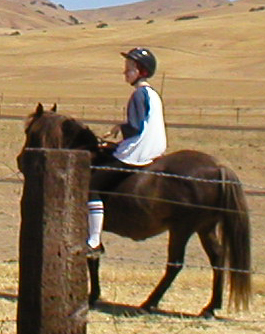 Annie Riding Sparky, Furball.
Annie Riding Sparky, Furball.
Donations can be made to in Annie’s name to care for the animal’s she so loved.
San Martin Animal Shelter
P.O. Box 526
San Martin, CA 95046


 Luckily, lice on horses can’t be transferred to people and Dr. Toews thought it not too likely that lice would spread to horses not in contact with the pony. Only three other horses also had to have lice treatment. This is better than all 15 horses at equestriantraining.com. The pony had to be shaved, put on antibiotics and given a soft diet that required less chewing. The pony and the three horses that live with him need a lice bath once a week for three weeks.
Luckily, lice on horses can’t be transferred to people and Dr. Toews thought it not too likely that lice would spread to horses not in contact with the pony. Only three other horses also had to have lice treatment. This is better than all 15 horses at equestriantraining.com. The pony had to be shaved, put on antibiotics and given a soft diet that required less chewing. The pony and the three horses that live with him need a lice bath once a week for three weeks.

